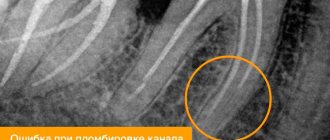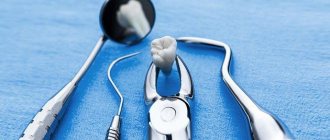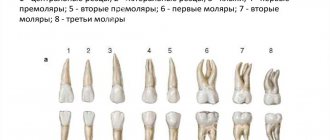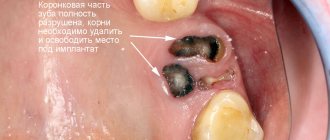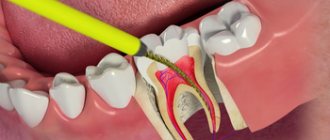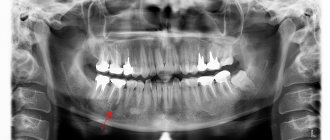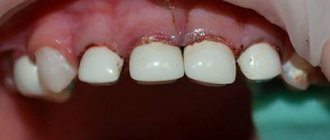When is it necessary to remove a nerve in a carious tooth?
If you delay visiting the dentist, caries can develop into serious inflammation of the pulp.
Bacteria destroy all tooth tissues, their integrity is disrupted, and the process reaches the pulp chamber, that is, the nerve. This disease is called pulpitis. When severe sharp or aching pain in a tooth appears, you should immediately consult a dentist. Without receiving timely treatment, the tooth will have to be removed. But if treatment is started on time, the nerve is necessarily removed, and the tooth is preserved and continues to perform its function.
In dental practice, there are known cases of traumatic pulpitis, the occurrence of which is influenced by a blow during an attack or accident. Typically, the frontal row of teeth suffers from such pulpitis.
Another cause of pulpitis is calculi, that is, dense deposits that appear in the dental canals due to metabolic disorders.
How long can an adult keep arsenic in a tooth?
Depulpation of a dental element is a procedure that allows you to kill a painful nerve that worries the patient. This manipulation requires the use of special painkillers, one of which is arsenic. To necrotize the dental nerve, arsenic paste is placed into the canal. To achieve the desired effect, the product must be kept for a certain time. Therefore, it is very important to know how much arsenic should be kept in the dental element.
Use in dentistry Arsenic paste is used in the treatment of pulpitis for the purpose of analgesic effects on the pulp. However, in this case there are indications and contraindications.
Arsenic must be used:
when a patient may have an allergic reaction to an anesthetic drug;
if the anesthetic drug used does not have the maximum effect;
there is not enough time for the anesthetic drug to take effect;
if the patient has recently suffered a heart attack;
the patient has hypertension;
the patient is under the influence of alcohol. Contraindications:
when the patient has an allergic reaction to arsenic or anesthetic drugs that contain arsenic;
if a child under three years old needs dental treatment;
tooth roots are not sufficiently formed;
if the patient is diagnosed with glaucoma;
when the patient has pathologies of the genitourinary system;
perforation of the roots of dental elements was diagnosed. Stages of treatment
The initiation of therapy must necessarily begin with an examination using an x-ray. Then, if the pathology is confirmed, the specialist opens the carious cavity and removes dead tissue. Arsenic paste is placed into the cleaned channel. The final steps include filling the dental element with a temporary filling. The doctor determines the duration of arsenic exposure. The second visit is characterized by the removal of arsenic from the tooth and the dead nerve is removed. This manipulation is absolutely painless.
How long should you keep arsenic paste in your tooth?
It is very important to determine how much arsenic should be kept. There are a lot of criteria here - the patient’s age, the drug used, pulp indicators (the drug is placed on a closed pulp or an open one). The average duration of exposure to arsenic on a nerve is 1 day. If multiple treatments are necessary, the doctor will increase the duration of action to two days. If we are talking about the treatment of dental elements of children, then the extraction of arsenic should occur no later than 16 hours later.
Attention! There are modern medicines that contain arsenic. Their effect on the diseased nerve can be increased to five days. Recommendations
Since arsenic paste is poisonous, safety rules must be followed. It is important to come to your next appointment at the time agreed with your doctor. First of all, follow this list of rules:
1) Maintain the integrity of the temporary filling. Initially, the filling is made airtight, so arsenic acts exclusively on the diseased nerve. If the integrity of the filling is damaged, arsenic comes out and affects the surrounding tissues. As a result, an inflammatory process occurs, which is accompanied by painful sensations.
2) Do not exceed the period of exposure to arsenic.
3) The specialist should not make a mistake with the dosage of the product.
What to do if you experience discomfort? Often the patient may experience discomfort when exposed to arsenic, to minimize anxiety, it is recommended:
rinse your mouth with soda solution if there is a sour taste. In this way, the acidic effect can be neutralized and burns can be avoided; after arsenic is introduced into the tooth, pain may occur; a glass of warm milk will be required to relieve it. To do this, hold the milk in your mouth for a few seconds, and then drink the drink completely.
Reference! Milk, namely the protein it contains, quickly removes arsenic from the body. How harmful is arsenic?
Since this product is a type of poison, it is used for dental purposes in minimal dosages, with strict adherence to safety rules. Proper use of arsenic minimizes harmful effects.
If the timing of exposure to arsenic is violated, it can penetrate the tissue structure, accumulate there and cause complications. If some of the arsenic gets into the oral cavity, then a protracted inflammatory process should be expected.
With incorrect dosages of arsenic, the following consequences are observed: 1) Dentin begins to blacken.
2) Swelling and inflammation of the pulp occurs.
3) Toxic effects on the body.
4) Inflammatory process of periodontal tissue.
5) Osteonecrosis.
Very often, the patient may ignore the deadlines indicated by the specialist. As a result, arsenic periodontitis occurs, the treatment of which requires a long time. When exposed to arsenic, tissue necrosis cannot be ruled out. If the patient experiences increased sensitivity, toxic damage to the intestines and liver subsequently occurs. Arsenic extraction process
In the depulpation procedure, it is very important to remove arsenic in a timely manner. If you ignore this indicator, you can get the above complications.
Advice! When the patient is unable to visit the doctor at the appointed time, the arsenic must be extracted independently. To do this, wash your hands and disinfect them in advance. Then break the integrity of the seal and remove the arsenic. The danger of manipulation is that it can be swallowed. Therefore, procedures should be carried out with extreme caution. Upon completion of the manipulation, the oral cavity must be rinsed with a soda solution. In this case, visit the dentist as soon as possible. Use of arsenic for pregnant women
If a woman is a nursing mother or is pregnant, then the use of products containing arsenic is strictly prohibited. This is due to the toxic effect on the baby. When a woman is short of pregnancy, it is important to warn the dentist about the situation. Modern dentistry is rich in safer medications that are approved for use by pregnant women. It is important! Additionally, auxiliary substances can be added to the paste, which are necessary for preparing a small dose.
The patient must remember that in no case should the duration of exposure to arsenic on the diseased nerve be exceeded, because this is fraught with dangerous consequences.
Dental treatment at the AVANTA dental clinic in St. Petersburg. Our specialists will conduct an initial examination and advise you. We are located next to the Mezhdunarodnaya metro station, at the address: Frunzensky district, Bela Kun street, building 2, building 1.
#dental treatment #dentistry
How is the nerve removed?
There are several ways to remove a nerve. Which one is needed in each specific case is chosen by the doctor in accordance with the clinical picture. The choice of treatment method depends on how damaged the tooth is and how deep the inflammatory process has penetrated.
Based on the results of the examination and examination, the dentist decides what kind of removal is needed: complete or partial. If the removal is partial, then the nerve is removed only in the crown part of the tooth, and the root is not affected. Partial removal of the nerve is used quite rarely; most often the dentist is forced to perform an operation to completely remove the nerve.
Preparing for channel cleaning
To assess the condition and structure of the root system, the patient is prescribed a preliminary diagnosis:
- CT scan;
- radiography;
- radiography;
After this, the dentist chooses a cleaning tactic and a special tool for the job.
Before opening the coronal part, local anesthesia is administered, since in a state of inflammation, internal structures can provoke acute pain. In this case, the dentist administers the anesthetic using the following methods:
- point or infiltration, that is, when injections are made into the projection of the apexes. An injection into the cancellous bone using the same infiltration method will also numb the area well;
- The conduction technique involves anesthesia of the nerve branch that surrounds the neighboring units. Anesthesia also affects some of the soft tissues, so after the injection and treatment, the patient may continue to experience unpleasant sensations in the immobilized part of the mouth for a long time.
Question about pain when removing a nerve.
Usually, when it is necessary to remove a nerve, patients succumb to the fear that this is a very painful procedure. But there is no point in worrying! Each qualified specialist in his arsenal has a large number of anesthetics that desensitize the diseased tooth and surrounding tissues. Just one injection, and the person does not feel anything in the area of the diseased tooth.
Local anesthesia is most often used. If the drug is chosen correctly, the entire operation from injection to nerve extraction will be completely painless.
Conservative treatment
The conservative method of treating pulpitis is also called “biological”; This method allows you to save the pulp. However, the conservative method can be used only in the early stages of the disease, when inflammation affects only a small part of the soft tissues of the tooth. Biological treatment is carried out for acute focal pulpitis, chronic fibrous pulpitis (in the absence of signs of periodontal inflammation), as well as in cases where the pulp chamber was opened accidentally.
Contraindications to the use of the method are:
- Periodontal inflammation
- Patient age over 45 years
- Caries of the neck or root of the tooth
- Low electrical excitability of dental tissues
- The need to install a bridge over the affected tooth
- Presence of allergic reactions
- Exacerbation of infectious and other chronic diseases during treatment
The conservative treatment procedure is carried out in several stages:
- Anesthesia (treatment is carried out under local anesthesia).
- Removing damaged tooth tissue using a drill and other dental instruments.
- Treatment of the cavity with antiseptic drugs.
- Degreasing and drying the carious cavity.
- Application of the drug and the insulating pad.
- Placement of a temporary filling.
Treatment of pulpitis without removing the nerve is aimed at relieving acute inflammation, eliminating pain, restoring metabolic processes in tooth tissue, and regenerating dentin. To achieve these goals, the patient may be additionally prescribed antibiotics, anti-inflammatory drugs, sulfonamides, enzymes and vitamins.
During the second visit, the doctor evaluates the results of treatment and checks the condition of the pulp using a thermal test and electroodontodiagnostics. If it is not possible to eliminate the inflammation using a conservative method, they move on to surgical methods.
Will my tooth hurt after pulpitis treatment?
The effect of the anesthetic drug wears off approximately 3 to 4 hours after the injection. The tooth sometimes begins to ache monotonously, and this pain can continue for some time. My tooth made itself felt for about two days. I stopped chewing on the left side of my jaw for several days to avoid getting hard food particles on the filled tooth, because at such moments the pain worsened significantly. These days I measured my body temperature, monitored my well-being, and was wary of complications.
My condition completely stabilized on the fourth day. I got used to the new filling, and the cured tooth stopped hurting. Now all I had to do was carefully monitor the health of my teeth and do everything to prevent deep inflammatory processes that lead to the removal of the nerve.
Surgery to remove a nerve frightens patients more with the unknown than it actually causes pain and discomfort. Toothache tends to be insidious and appear unnoticed, so I recommend everyone not to start inflammatory processes in the oral cavity, consult a dentist in time and not let the matter go to the point of removing the nerve. If indications for removal still appear, feel free to go to a professional and competent doctor. The doctor will select a good anesthetic for you, treat your aching tooth and relieve the pain forever.
Removal with arsenic
Once upon a time there was only one way to remove it, it was terribly painful, especially since you had to visit the doctor several times. At first, the doctor drilled the tooth down to the pulp with a drill, which was extremely painful. Next, arsenic was placed in the hole and it was temporarily sealed with a filling. In a couple of days, the arsenic dealt with the nerve, and the tooth hurt so much that no medicine could help. Then I had to go to the doctor again, he opened the temporary filling, removed the nerve, and cleaned the root canals. Pulp is a tenacious substance, so this process was also extremely painful.
This technology poses a certain danger, because arsenic is a poison, and the doctor, when using it, must be especially careful, and the patient must be careful: if you are late with the second visit to the doctor and leave arsenic in the tooth, it will completely destroy it, which will end deletion. Dentists stopped using arsenic and developed new techniques for removing pulp.
Contraindications to the use of arsenic paste
It is not always allowed to use arsenic paste as an anesthetic. The main contraindication is hypersensitivity to its composition. Also, doctors do not recommend using the drug in the following situations:
- children under 1.5 years of age;
- the roots have not yet fully formed;
- the dental canals are poorly cleaned, it is not possible to carry out a complete sanitation of the oral cavity;
- the presence of artificial holes in the root;
- increased intraocular pressure;
- pathologies of the urinary system;
- period of pregnancy and lactation.
Restrictions that apply to children, pregnant and lactating women are completely justified. In this category of patients, treatment is carried out using other methods. Even a small dose of arsenic, if it enters the gastrointestinal tract, can cause undesirable consequences.
Despite the rapid development of dentistry, dentists still actively use arsenic in their practice. In the hands of an experienced specialist, this substance allows you to carry out therapy without severe pain. The main thing is to follow all the doctor’s recommendations after adding arsenic paste and possible restrictions, and if uncharacteristic symptoms appear, you need to seek medical help again.
How to remove toothpaste from a tooth yourself
Sometimes it happens that after a temporary filling and arsenic paste have been placed, the patient cannot come to the dentist on time to complete the treatment. You cannot leave it longer than expected. Therefore, you can try to extract the composition yourself at home.
- First of all, we must not forget about personal hygiene. Before manipulations, you must wash your hands with soap and treat them with any antiseptic. You will also need to brush your teeth thoroughly. Instruments for manipulation (tweezers, needles) should be disinfected. The most acceptable option is boiling or processing in a weak solution of potassium permanganate.
- The temporary filling should be carefully pryed with a needle and removed. Usually this does not cause any particular difficulties. For a better overview, it is recommended to carry out manipulations in front of a mirror. The main thing is not to touch neighboring healthy areas or go deeper into the tooth cavity.
- Under the filling there is arsenic paste. Usually it has a characteristic grayish tint. You need to take out the paste very carefully and make sure that it does not crumble. If particles of the composition get on the mucous membrane, they should be removed immediately.
- At the next stage, the oral cavity must be rinsed. A solution of soda or chamomile is suitable for this.
- It is recommended to close the open dental cavity with a cotton pad or swab.
After the procedure, it is necessary to visit the dentist as soon as possible, because an open canal is an easy path for infection. If the nerve is not removed in a timely manner, it will begin to decompose, affecting healthy areas. If arsenic paste is left in the mouth for some time, it will destroy the periapical tissues. Then periodontitis will begin to develop very quickly. After another 3 days, the tooth will decay and turn black. All this is dangerous due to the appearance of complications when the dental unit cannot be saved.
Depulpation procedure
Modern dentistry performs depulpation quickly and painlessly, using anesthesia. Therefore, to the question of many patients about whether it is painful to fill canals and remove a nerve from a tooth affected by caries, one can unequivocally answer that in case of proper anesthesia, there is no pain. Patients feel some discomfort during anesthesia during the injection. However, such pain lasts literally a second, and soon the tooth and the tissue around it begin to go numb, as a result the patient does not feel anything.
Removal of the nerve takes place in one session and consists of several stages.
- Before starting the procedure, the doctor sends the patient for an x-ray. The image will show how badly the tooth is damaged.
- This is followed by anesthesia if there are no contraindications to the use of anesthesia.
- By removing damaged tissue, the doctor provides himself with easy access to the pulp being removed.
- The depulpation procedure is performed using dental instruments.
- The procedure is completed by filling the canals and installing a filling.
In some cases, the dentist puts a temporary filling and releases the patient for a few days. At the second visit, an x-ray is taken again, which allows you to evaluate the quality of the canal filling, and then a permanent filling is installed.
What to do if complications arise when using arsenic
If the doctor correctly selected the dosage and hermetically installed the temporary filling, and the patient came for a follow-up appointment on time, there will be no complications after using the paste. They occur if the therapist used too much of the substance, did not install the filling tightly and it fell out, or when the patient missed the deadline for taking it and walks with arsenic longer than expected.
The most common complications include:
- Burn of the mucous membrane, for example, gums;
- Necrosis of surrounding tissues and pulp of adjacent teeth;
- Arsenic periodontitis and periodontitis;
- Osteonecrosis is the destruction of jaw bone cells.
If arsenic falls out, the patient has a headache, feels sick and vomits, contact the clinic immediately. When the poison enters the body, the doctor administers an antidote. In case of damage to the mucous membrane, treat the affected area with antiseptics and drugs that block the spread of the toxin and accelerate tissue epithelization.
In modern dentistry, to avoid overdose, the paste is produced in special granules. The main thing that doctors urge is not to overexpose arsenic: keep it for as long as you are prescribed to walk with it. Then the risk of complications becomes minimal.
Modern methods of endodontic treatment
In the treatment of tooth canals today there are two approaches: therapeutic and surgical. Let's look at them in more detail:
Therapeutic treatment. With this method, it is possible to preserve the entire pulp or at least part. The drug is placed into the cavity. The pulp chamber is isolated using a special gasket, then the tooth is filled. The drug can also reach tissues through dentin. To do this, special bandages with antibiotics are applied to the tooth. This therapy is used only in the initial stages of the inflammatory process.
Surgery. In this case, the pulp is completely removed, the canals are cleaned, disinfected and sealed. There are the following methods for filling cavities:
- Classical. The canals are filled with conventional filling material.
- Vertical filling. A special filling composition is administered as an injection.
- The use of thermophiles. A special heated composition on a carrier is placed into the cavity.
Sometimes, in order to cure the canal, you have to remove the tip of the root. This measure is necessary for cysts, granulomas, perforations, fibroids and other problems.
Forms of pulpitis and their symptoms.
Symptoms of pulpitis are contradictory and depend on the form in which this disease manifests itself.
There are 2 main forms of pulpitis:
- Acute pulpitis.
Symptoms of acute pulpitis:
- Attacks of acute, throbbing pain that begin suddenly and spontaneously, often at night. As the disease progresses, the light intervals between attacks become smaller and the pain becomes stronger.
- The pain radiates to the ear, neck, face, the patient cannot say which tooth hurts.
- In the interval between attacks, pain can be triggered by temperature changes - a sharp reaction to hot and warm, with temporary relief from cold.
- Unlike caries, with pulpitis the pain does not go away after removing the irritant and continues for up to 15 minutes.
This is an acute condition that needs to be treated without delay, because... purulent complications are possible.
- Chronic
If acute pulpitis is not treated, the inflammatory process gradually subsides and becomes chronic.
Symptoms of chronic pulpitis:
- The pain is unexpressed, aching, and is provoked by temperature changes.
- Perhaps no pain at all.
Periodically, chronic pulpitis worsens, and then it is characterized by symptoms of acute pulpitis. As a complication of this condition, cysts and granulomas often form on the roots of the tooth.
Why does pulpitis begin?
- The most common cause of pulpitis is untreated caries. The carious process worsens, the carious cavity deepens, and eventually the pulp chamber, which contains the “nerve,” is destroyed. Bacteria from the carious cavity enter and infect the pulp - inflammation begins.
Also, the cause of pulp inflammation can be:
- Mechanical damage to the pulp as a consequence of trauma.
- A complication after inaccurate tooth preparation during various dental procedures.
